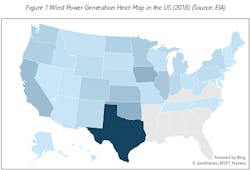HVDC: A Building Block for a Resilient, Flexible and Interconnected Grid
The metaphorical ‘War of the Currents’ between AC and DC started by reigning geniuses of the 1880s, George Westinghouse Jr., Nicola Tesla, and Thomas Alva Edison. As we all know, initially three phase alternating current (AC) won and ruled the power transmission arena; however, with the increasing bulk power transmission capacity and longer transmission distances, DC technology has again started to make sense as a transmission medium. Just like other power converter-based technologies in the early 1900s, high voltage direct current (HVDC) started its journey with mercury-arc-rectifiers. After a series of experiments and small scale implementation projects in 1930s, the first commercial HVDC was installed in 1954 between the island of Gotland and the Swedish mainland by Allmänna Svenska Elektriska Aktiebolaget (ASEA, also known as General Swedish Electric Company), the Sweden based company in Västerås, now ASEA Brown Bovari or ABB,. Based in Zurich.
With advancements in voltage-source converters (VSC), HVDC is now considered a mature technology for bulk power transmission over long distances while providing flexibility for connecting asynchronous power grids. The potential benefits of HVDC over a conventional AC transmission system are highly recognized, primary among them is the controllability which increases the overall reliability of an interconnected grid. This article explores how HVDC transmission will be the key enabler of emerging single energy market.
Flexibility for integrating clean energy
For many utilities around the globe, the integration of low carbon energy sources with the transmission and distribution (T&D) grid is a critical topic. As the distribution of these renewable sources is uneven and often at long distances from electricity load centers (especially offshore wind), AC transmission systems face additional challenges in terms of losses and reactive power requirements. In extreme cases, HVDC remains the only viable option when the life cycle cost (LCC), including system losses of the transmission systems, is taken into consideration.
Several cross border HVDC links installed in Europe serve the purpose of transmitting clean renewable energy across the grids. Country-wide HVDC projects in some European countries are also installed for transport of renewable energy towards load centers. For example, Germany has several HVDC projects (in operation and planned) which connect offshore wind power with its transmission grid. A shift was observed in Chinese market as well, where previously HVDC projects were installed for long-distance bulk power transfer, which now has many HVDC projects planned and in-operation to integrate wind power with its grid. Similarly, a lack of HVDC projects in the US is expected to end with the ‘Plains and Eastern clean line HVDC’ project which promises to transport renewable energy across different states.
Because of increasing maturity in the technology, HVDC presents opportunity in terms of cross-continent interconnections for renewable energy integration. For example, there are some Euro-African HVDC projects under consideration which can potentially bring the benefits of massive solar potential in North Africa to the European grid. One such study shows that roughly 5 gigawatt (GW) of carbon-free electricity can be transferred via HVDC links from the Sahara solar complex to the European grid, where reduced dependence on fossil fuel and nuclear generation is a necessity to comply with regional clean energy goals.
China, the global leader
Over the past decade, China has emerged as a global leader in the HVDC market in both installed projects and R&D efforts. From 2009, began the era of ultra high voltage direct current (UHVDC), primarily due to multi-GW HVDC transmission projects constructed by China. Roughly 60% of the HVDC projects installed in China after 2010 were of a 3GW size or more. In addition, State Grid of China (SGCC) plans to spend roughly US$90billion just in UHVDC interconnections from 2009 to 2020, and making more than 20 UHVDC transmission links operational by 2030. The recently commissioned Zhundong-Wannan ±1100kV UHVDC link in China is a real breakthrough in DC transmission having a total capacity of 1GW. In addition to UHVDC, China has implemented unique HVDC topologies such as multi-terminal vehicle stability control (VSC) projects, paralleled LCC and VSC, and even a hybrid LCC and VSC project is in the pipeline. Under the ‘Belt and Road Initiative’ there are currently discussions around building multiterminal HVDC connections between China and Europe, including several other Asian countries. With multiple R&D institutes and HVDC labs operating under SGCC, it can safely be predicted that China will continue to introduce new technologies in this field, maintaining its position as a global HVDC market leader for the next decade.
United States lagging in HVDC?
As described earlier, an uneven geographical distribution of renewable generation is a key driver of HVDC market, the US being a model example. A distribution of wind power in the US is depicted in the heat map below.
The generation density clearly necessitates the need for long distance DC transmission system to evacuate the wind power from the high-density mid-west to the eastern part of the country. Despite this need, there has not been a single HVDC project since 2010. If we look at the operating DC voltage (kV) and transmission capacity (GW) of existing HVDC projects, the US has yet to achieve UHVDC (>800kV DC). In terms of HVDC topologies, US has installed few VSC based HVDC projects whereas Europe and China have several VSC HVDC projects. Upcoming HVDC projects like the Plains and Eastern clean line could be a positive start to a bigger goal of a North American Supergrid (NAS or Supergrid) which proposes a 52-node HVDC connection throughout the lower 48 states. Such a DC connected paradigm would result in a resilient network and provide the necessary competitive boost to the renewable energy against currently dominant fossil fuel-fired generation in the US.
Multi-terminal HVDC - a step towards a DC grid
With the deployment of larger capacity offshore wind plants, there is a need for operational characteristics like bi-direction power flow and enhanced control. The mature conventional technology known as line commutated converters (LCCs) using thyristors is not enough to provide this flexibility due to its constant current-carrying capability. This technology only allows the control of the active power and lacks the black start capability, a unique quality of voltage source converters (VSC) using insulated-gate bipolar transistors (IGBTs) as the switching elements. Though less mature, VSC based multi-terminal DC (MTDC) grid is going to be the core of future HVDC meshed networks.
The successful implementation of point-to-point HVDC suggests the concept of Supergrid is most likely to be achieved via MTDC lines, which provide the most cost effective and efficient solution of interconnecting multiple converter stations through DC network. However, there are few examples of implementation of MTDC using LCC based technology because of its high capacity carrying capability like North East Agra MTDC HVDC project that has been put into operation in 2017 (LCC based three terminal project having total capacity of six GW).
Implementation of future meshed HVDC grids is feasible only with VSCs. Like a conventional AC grid, VSC has the capability of power reversal within an MTDC grid simply by the reversal of current direction while maintaining the voltage at both ends making it an ideal choice for meshed DC grids. Zhoushan multi-terminal HVDC project commissioned in 2014 in China is the first high voltage project interconnecting five terminals using VSC HVDC. Though its capacity is only 400 megawatt (MW), much less than the conventional LCC based HVDC, but the flexibility and control outweigh this aspect.
Future HVDC grids along with numbers of benefits also require efforts in terms of its protection and control. Major HVDC market competitors like ABB, Siemens, GE and some other players are all involved to resolve these issues. Unlike the AC grids, there is no possibility of zero-crossing clearance in DC grid fault protection. The present day HVDC converters possess “non-fault blocking” capability and in case of fault, the short circuit current continues to build inside the DC system unless the AC side protection is operated and shut down the whole DC network, which is obviously an inefficient method. This issue can be resolved by DC circuit breakers which are way more complex and expensive compared to AC circuit breakers and require high degree of precision. With the advancements in DC breaker, new possibilities are opening towards realization of meshed DC networks.
Edison’s DC + Multi-terminal VSC = Grid 2.0
It took over a century but Edison’s vision for a DC grid may be closer than ever with the help of VSC technology. China has now become the technological polestar of HVDC transmission due to several ultra high capacity projects installed and planned for its grid. Europe will continue to see growth in HVDC market specially in VSC based projects. Plus, we can expect new projects in emerging markets like South America, Pakistan and Africa.
About the Author
Saqib Saeed
Chief Production Officer
Saqib is a highly accomplished market research professional and a data storyteller in the international energy industry. With over a decade of experience in the field, he currently serves as the Chief Product Officer at PTR Inc. His expertise lies in the power grid and e-mobility equipment sectors. Saqib has overseen numerous global market research studies throughout his career and provided valuable insights to key decision-makers at various Fortune 500 companies. He is a member of the editorial board for Transformers Magazine and a member of the Advisory board of CWIEME Berlin and Middle East Energy. In addition to his market research career, Saqib has worked as an Electrical Engineer in the manufacturing sector.

